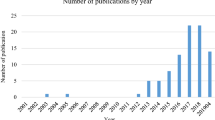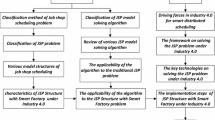Abstract
In a wafer manufacturing system, the value added to a particular product at a station may differ significantly from that added to a different product at the same station. If an enterprise concentrates mainly on generating profits, throughput becomes a poor performance measurement for a manufacturing system. Job dispatching rules based on maximum throughput no longer guarantee maximizing profit. Hence, profitability would be a good alternative measurement. The main purpose of this study is to develop a production-flow-value-based job dispatching rule (PFV) by the theory of constraints (TOC) for wafer fabrication. This study derives a TOC cost estimation method and a profitability estimate of a WIP-wafer lot. Jobs are then prioritized based on their profitability. Thus the PFV job dispatching rule is developed. For comparison, two job dispatching rules, MCR and MBS, are also arbitrarily selected to perform simulations. The simulation results reveal that the proposed PFV maximizes the production flow value, while MCR and MBS do not.
Similar content being viewed by others
References
Blackstone JH, Philips DT, Hogg GL (1982) A state-of-the-srt survey of dispatching rules for manufacturing job shop operations. Int J Prod Res 20(1):27–45
Panwalkar SS, Iskander W (1997) A survey of scheduling rules. Oper Res 25(1):45–61
Uzsoy R, Lee CY, Martin-Vega, LA (1992) A review of production planning and scheduling models in the semiconductor industry. Part I: System characteristics, performances evaluation and production planning. IIE Trans 24(4):47–58
Uzsoy R, Lee CY, Martin-Vega LA (1994) A review of production planning and scheduling models in the semiconductor industry. Part II: Shop-floor control. IIE Trans 26(5):44–55
Pierce NG, Yurtsever T (2000) Value-based dispatching for semiconductor wafer fabrication - VBD. IEEE/SEMI Advanced Semiconductor Manufacturing Conference, 12–14 Sept 2000
Lewis RJ (1995) Activity-based models for cost management systems. Quorum Books, Westport, CN
Kee R, Schmidt C (2000) A comparative analysis of utilizing activity-based costing and the theory of constraints for making product-mix decisions. Int J Prod Econ 63:1–17
Gunasekaran A, Sarhadi M (1998) Implementation of activity-based costing in manufacturing. Int J Prod Econ 56–57:231–242
Boons NAM (1998) Product costing for complex manufacturing systems. Int J Prod Econ 55:241–255
Goldratt EM (1993) What is the theory of constraints? APICS-The Perform Advant 3:46–55
Blackstone JH (2001) Theory of constraints - a status report. Int J Prod Res 39(6):1053–1080
Lockamy A, Spencer MS (1998) Performance measurement in a theory of constraints environment. Int J Prod Res 36(8):2045–2060
Fredendall LD, Lea BR (1997) Improving the product mix heuristic in the theory of constraints. Int J Prod Res 35(6):1535–1544
Hsu T-C, Chung S-H (1998) The TOC-based algorithm for solving product mix problems. Prod Plan Control 9(1):36–46
Baker KR (1974) Introduction to sequencing and scheduling, Wiley, New York
Baudin M (1990) Manufacturing systems analysis with application to production scheduling, Prentice-Hall, New York
Glassey CR, Resende MGC (1988) Closed-loop job release control for VLSI circuit manufacturing. IEEE Trans Semicond Manuf 1(1):36–46
Lozinski C, Glassey CR (1988) Bottleneck starvation indicators for shop-floor control. IEEE Trans Semicond Manuf 1(4):147–153
Ikura Y, Gimple M (1989) Efficient scheduling algorithms for a single batch processing machine. Oper Res Lett 5(2):61–65
Glassey CR, Weng W (1991) Dynamic batching heuristic for simultaneous processing. IEEE Trans Semicond Manuf 4(2):77–82
Fowler JW, Phillips DT, Hogg GL (1992) Real-time control of multiproduct bulk service semiconductor manufacturing processes. IEEE Trans Semicond Manuf 5:158–163
Weng WW, Leachman RC (1993) An improved methodology for real-time production decisions at batch-process workstation. IEEE Trans Semicond Manuf 6(3):219–225
Robinson JK, Fowler JW, Bard JF (1995) The use of upstream and downstream information in scheduling semiconductor batch operation. Int J Prod Res 33(8):1849–1869
Van Der Zee DJ,Van Harten A, Schuur PC (1997) Dynamic job assignment heuristic formulti-server batch operations-a cost based approach. Int J Prod Res 35(11):3063–3093
Acknowledgements
The authors would like to thank the National Science Council of the Republic of China, Taiwan for financially supporting this research under Contract No. NSC90-2212-E-002-210.
Author information
Authors and Affiliations
Corresponding author
Appendix
Appendix
Rights and permissions
About this article
Cite this article
Hsieh, S., Hou, KC. Production-flow-value-based job dispatching method for semiconductor manufacturing. Int J Adv Manuf Technol 30, 727–737 (2006). https://doi.org/10.1007/s00170-005-0105-y
Received:
Accepted:
Published:
Issue Date:
DOI: https://doi.org/10.1007/s00170-005-0105-y




